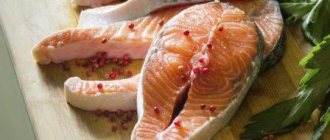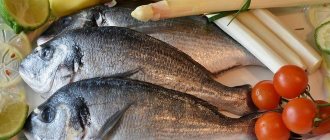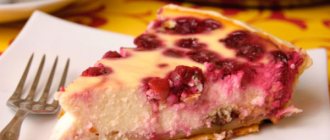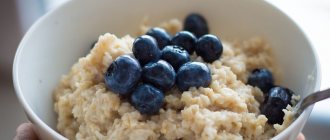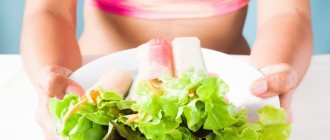Scientists have long proven that fish plays a key role in dietary nutrition. A gastroenterologist will explain what kind of fish you can eat if you have concomitant diseases, but its presence in the diet is mandatory. Therefore, it should be included in the menu of those losing weight. Useful microelements and vitamins ensure health, and Omega-3 fatty acids will give beauty to hair and nails. Therefore, eating fish will not only help you get rid of extra pounds, but also maintain your external beauty.
The most dietary
Fish and seafood are considered lower in calories than meat and, when consumed correctly, do not contribute to weight gain. In addition, the fish is well absorbed in the human body, nourishing it with iodine, protein, phosphorus, and even zinc. Each fish is unique in its own way.
First of all, varieties of fish products are divided into three categories:
- fatty varieties (fish with a high % fat content). It is not recommended to choose fatty varieties when you have high cholesterol.
- moderately fatty varieties (perch, catfish, carp, carp).
- skinny varieties (pike, catfish, chum salmon).
You need to know that the fat contained in fish is very useful because it has a positive effect on almost the entire body system. Therefore, if you do not adhere to strict diets, then you can safely include fatty fish in your diet. Well, if you are still a follower of a healthy diet, then it is best to stop at choosing skinny varieties.
Tuna is considered the most dietary. It is rich in fatty acids, omega-3, vitamins A and B. This fish is very simple to prepare: it can be used in a casserole, sandwich, salad or pasta.
Yandex pictures
Fish by fat content category
When determining the nutritional value of fish meat, the percentage of fat in it is taken into account.
According to this parameter, 3 large categories are distinguished:
- Marine and freshwater species, in the soft tissues of which the fat content does not exceed 4%. These varieties are most suitable for eating if a person needs to follow a diet for weight loss.
- Conditionally low-calorie fish, the fat content of which does not exceed 8%. It is recommended to periodically include it in the diet even for people with severe obesity, because... it will help eliminate the deficiency of essential amino acids necessary for the normal functioning of all body systems.
- Varieties of fish with a fat content of 8.5–36%. They are recommended to be included in the diet when following the keto diet.
The fat content is not considered stable. It may vary depending on the season, conditions, food supply and many other parameters.
Low-fat varieties
Low-fat fish varieties are those that contain no more than 4-5 percent fat. According to scientists, such dietary fish contain a large amount of iodine, which is very useful for the normal functioning of the thyroid gland and rapid metabolism.
Marine
Low-fat varieties of sea fish include the following types:
- blue whiting.
- flounder.
- cod.
- pollock.
- vobla.
- seabass
- hake.
- pollock
- haddock.
Yandex pictures
White
This list contains white lean fish:
- cod.
- haddock.
- halibut.
- navaga.
Red
This list contains red low-fat dietary fish:
- pink salmon.
- trout.
Yandex picture
River
Low-fat varieties of river fish include:
- perch.
- pike.
- zander.
- tench.
- bream.
Yandex pictures
Fish calorie table
The table indicates the amount of fats, proteins, carbohydrates per 100 g of product. From them you can determine the calorie content and varieties suitable for preparing dietary fish.
| Fish name | Calories, kcal | Proteins, g | Fats, g | Carbohydrates, g |
| Low fat | ||||
| Boiled flounder | 103,00 | 18,3 | 3,3 | — |
| crucian carp | 102,00 | 20,7 | 2,1 | — |
| Mackerel | 124,00 | 22,8 | 3,6 | — |
| Pollock | 79,00 | 17,6 | 1,00 | — |
| Burbot | 92,00 | 21,4 | 0,7 | — |
| Sea bass | 112,00 | 19,9 | 3,6 | — |
| Blue whiting | 81,00 | 17,9 | 1,00 | — |
| Zander | 97,00 | 21,3 | 1,3 | — |
| Cod | 69,00 | 18,5 | 0,7 | — |
| Hake | 95,00 | 18,5 | 2,3 | — |
| Pike | 97,00 | 21,3 | 1,3 | — |
| Shrimps | 95,00 | 18,9 | 2,2 | — |
| Krill | 98,00 | 20,6 | 1,7 | — |
| Crabs | 96,00 | 16,00 | 3,6 | — |
| Mussels | 50,00 | 9,1 | 1,5 | — |
| Tuna | 96,00 | 22,5 | 0,7 | — |
| Horse mackerel is cold. smoking | 94,00 | 17,1 | 2,8 | — |
| Medium fat | ||||
| Boiled pink salmon | 168,00 | 22,9 | 7,8 | — |
| Pink salmon | 136,00 | 20,9 | 5,6 | — |
| Catfish | 114,00 | 15,5 | 5,8 | — |
| Carp, carp | 125,00 | 19,4 | 5,3 | — |
| Bream | 126,00 | 20,9 | 4,7 | — |
| Salaka | 159,00 | 22,00 | 7,2 | — |
| Horse mackerel | 133,00 | 20,8 | 5,6 | — |
| Squid | 110,00 | 18,00 | 4,2 | — |
| Chum salmon | 129,00 | 21,5 | 4,8 | — |
| Cold smoked mackerel | 150,00 | 23,4 | 6,4 | — |
| Dried roach | 235,00 | 46,4 | 5,5 | — |
| High fat | ||||
| Sardine | 178,00 | 20,1 | 10,8 | — |
| Mackerel | 211,00 | 19,6 | 14,7 | — |
| Som | 196,00 | 18,4 | 13.6 | — |
| Halibut | 201,00 | 14,00 | 17,8 | — |
| Beluga blanched | 234,00 | 23,3 | 15,6 | — |
| Carp in tomato sauce | 145,00 | 12,4 | 8,7 | 4,1 |
| Red sockeye salmon | 170,00 | 18,8 | 10,5 | — |
| Sturgeon | 183,00 | 16,4 | 10,6 | — |
| Spicy salted sprat | 154,00 | 14,8 | 10,5 | — |
| Flounder fried in oil | 249,00 | 14,4 | 21,3 | — |
| Saira blanched in oil | 283,00 | 18,3 | 23,3 | — |
| Salted pink salmon | 189,00 | 22,1 | 9,00 | — |
| Salted chum salmon | 184,00 | 24,3 | 9,6 | — |
| Salted salmon | 269,00 | 21,00 | 20,5 | — |
| Iwasi salted herring | 173,00 | 17,5 | 11,4 | — |
| Hamsa salted | 166,00 | 21,2 | 9,00 | — |
| Salted sprat | 225,00 | 19,8 | 18,2 | — |
| Hot smoked flounder | 192,00 | 22,00 | 11,6 | — |
| Hot smoked sprat | 162,00 | 21,3 | 8,5 | — |
| Sea bass is hot. smoking | 175,00 | 23,5 | 9,00 | — |
Wild salmon
General characteristics: Wild salmon belongs to the salmon family. The length of the body can reach two meters and weight up to 70 kg. The aroma and taste of the meat is pleasant and tender.
Energy value and nutritional value of the product per 100 grams: 143 kcal - calorie content, proteins - 19.9 g, fats - 6.4 g, carbohydrates - about g.
Benefits: Nutrients contained in wild salmon provide skin elasticity, improve the appearance of hair, and blood circulation.
Interesting fact: salmon increases alertness and improves memory in humans. It is also very useful when boiled.
Disadvantages: Raw salmon may contain parasites harmful to the human body (helminitis). Fish is also dangerous for people with an allergic reaction to seafood.
Price per kilogram: On average 1800 rubles for fresh salmon and 1000 rubles for frozen salmon.
What to look for when choosing:
- The eyes of the fish should not be cloudy (if you buy a whole fish).
- Salmon should not smell like fish (it usually gives off a "sea" aroma).
- The correct fillet color is pink or pale orange. Too bright a shade indicates the presence of dyes in the composition.
What is best to cook with: Salmon goes well with almost all foods. Salmon cooked with lemon, tomatoes, capers in the oven will be a win-win. The fish soup is also excellent!
Yandex picture
How is it different from other fish?
Pike perch, pike, bersh and perch are predator fish that are visually similar to each other, so it is necessary to be able to distinguish them by their individual external features.
From bersh
Bersch is a type of pike perch, which is distinguished by its smaller size and the absence of a large jaw. In addition, the bersh swims in a school. While fishing, he grabs the bait, and the pike perch pecks at the bait, trying to stun it with a blow. Bersh have large scales, which are even present on the fins, while pike perch have clean fins.
From perch
The perch fish has a compressed, round body of a greenish color with a white belly. A distinctive feature of the perch is a black spot on the dorsal fin. Perch can be distinguished from pike perch by the shade of the lower lateral fins and tail, colored yellow or red. In addition, perches are smaller in size and reach a length of up to 20 cm; carcass weight varies from 1 to 2 kg.
From pike
The freshwater pike fish is distinguished by a long, thin body, the length of which reaches 1.5 m. The head is large and the mouth is wide. The average weight of an adult is 8 kg. The color is greenish, but, unlike pike perch, the paired fins are not pale, but orange.
Tuna
General characteristics: Tuna is a marine fish for diet, the mackerel family. Body length varies from 50 centimeters to 4.5 meters, and weight from 1.5 to 680 kilograms.
Energy value and nutritional value of the product per 100 grams: 100 kcal - calorie content, proteins - 23 g, fats - 1 g, carbohydrates - about g.
Benefits: Thanks to the beneficial properties of tuna, you will reduce the risk of cancer, improve the condition of your hair and nail plate, increase brain activity, speed up your metabolism and strengthen your immune system.
Disadvantages: This fish is capable of accumulating mercury in its tissues, which can have a detrimental effect on the human body. When a woman is pregnant, she is not recommended to eat tuna.
Price per kilogram: On average, a tuna fillet costs 1,300 rubles, and a whole fish costs 1,000 rubles.
What to look for when choosing:
- The correct color for tuna is red or dark red. A brown tint indicates the presence of dyes in the fish.
- If you purchase canned tuna, then pay attention to the inscription “dolphin friendly” - this means that no dolphins were harmed while fishing for tuna.
- The bones in tuna fillets should not be discolored.
What is best to cook with: As a side dish for tuna, it is better to serve mashed potatoes or cauliflower. Lemon is the “best friend” of any fish and tuna is no exception. Fish is used in many dishes: pizza, sushi, casseroles, pies, cutlets, soups, etc.
Yandex pictures
What fish to eat when losing weight - TOP6
Wild salmon
Wild salmon is a red fatty fish rich in omega-3 fatty acids and is therefore considered one of the best fish for weight loss. You will get 200 calories from 100g of salmon. It is rich in vitamin A, folic acid, niacin, vitamin B 12, calcium, magnesium, phosphorus and protein. In fact, scientists found that eating salmon helped reduce BMI by 5.6% compared to whey protein.
Tuna
Canned or not, tuna is good for you if you're trying to lose weight. It is rich in omega-3 fatty acids, EPA and DHA. A bowl of canned tuna will provide you with 179 calories and 39.3 grams of protein. Tuna is also a good source of calcium, iron, potassium, phosphorus, vitamin A, folic acid, niacin and vitamin B 12. This fish can be easily prepared in tuna salad, sandwiches, casserole or pasta.
Mackerel
Mackerel is a fatty fish that is a close relative of tuna. Is it possible to eat mackerel while losing weight? Of course yes, like any other fish! It contains high amounts of protein, omega-3 fatty acids, EPA, DHA, vitamin B 12 and selenium. All of these nutrients help reduce inflammation, improve metabolic rate and build muscle mass. Dietary dishes from this fish are simply amazing. You can boil it, fry it, stew it, or make curry out of it.
Herring
Like any other fatty fish, herring is also rich in omega-3 fatty acids. You will get 210 calories from 100 grams of herring fillet. It is also a good source of vitamins A, D and B12, calcium, phosphorus, potassium and selenium. Steam or grill herring with vegetables, you will definitely like it. The FDA recommends consuming herring twice a week.
Pacific cod
Cod liver oil is already known for its hair growth and health benefits. But if you are not comfortable taking dietary supplements, you can eat cod directly. You will get 90 calories from 100g cod fillet. It is an excellent source of vitamin A, choline, magnesium, calcium, phosphorus, potassium and selenium.
Hilsa
Hilsa belongs to the herring family and you can get 330 calories from 100 grams. It is mainly found in India, Bangladesh and Sri Lanka, but hilsa is available all over the world. It is also a very good source of vitamin C and calcium.
The 6 fish listed above will help you reach your goal weight. But you can include any other fish in your diet and see good results. Now let me give you an idea of what a diet chart should look like
Mackerel
General characteristics: Mackerel is a diet fish from the mackerel family. She reaches a height of 30 cm and a body weight of 350 grams (on average). Mackerel differs from other fish by its specific smell and bright taste.
Energy value and nutritional value of the product per 100 grams: 140 kcal - calorie content, proteins - 11.3 g, fats - 11 g, carbohydrates - 1.2 g.
Benefits: Mackerel contains substances that help remove carcinogens from the body, reduce the risk of heart attack, stroke, and even cancer, activate brain activity, normalize blood pressure and blood circulation.
Disadvantages: You should not eat fish if you have diabetes, inflammation of the pancreas, bleeding disorders, liver and stomach disease, as well as if you are individually intolerant to mackerel.
Price per kilogram: On average, a marinated mackerel carcass costs 300 rubles, frozen - 450 rubles per kilogram.
What to look for when choosing:
- The surface of the fish carcass should be smooth, without dents or damage. If you still find the above mentioned, then you should not take such a fish.
- The skin of the fish must be intact.
- The mackerel's eyes should not be cloudy.
What is best to cook with: Since mackerel has a rich taste, it is better to balance it with products whose taste properties are less pronounced, for example, cucumber. In order to emphasize the bright taste of fish, you should choose lemon, tangerine or orange as a dressing.
Yandex pictures
Advantages and disadvantages
What is good about low-calorie fish:
- contains easily digestible protein, minerals, healthy fatty acids, vitamins (A, all group B, D, C);
- fits into the framework of weight loss diets, treatment tables and a proper nutrition system;
- included in the menu of pescatarians (a branch of vegetarianism), preventing them from developing anemia, vitamin deficiencies and protein deficiency;
- reduces cholesterol;
- reduces the risk of developing CVD;
- useful when playing sports against the background of dietary nutrition: prevents the breakdown of muscle fibers;
- improves digestion;
- has a positive effect on the nervous system;
- helps with thyroid diseases;
- speeds up metabolism.
What disadvantages should you be aware of:
- inferior in taste to high-calorie fish, as it is more watery;
- not as nutritious;
- There are practically no red fish among low-calorie varieties;
- may contain harmful substances (even mercury) if found in polluted areas;
- increases the risk of developing helminthiasis;
- is a powerful allergen;
- may cause unwanted side effects - poisoning, intestinal disorders, diarrhea.
For fish to be beneficial, it must be chosen and prepared correctly.
Herring
General characteristics: Herring is a sea fish, which is also called “herring”. The average length is 45 cm, and the weight of the fish is 500 grams. It has juicy meat and rich flavor.
Energy value and nutritional value of the product per 100 grams: 135 kcal - calorie content, proteins - 17 g, fats - 7 g, carbohydrates - 0 g.
Benefits: Herring contains such a useful substance as selenium, it is a natural antioxidant. Also, by consuming herring you will reduce the risk of blood oxidation, improve vision, blood pressure, and accelerate the regeneration of skin cells.
Disadvantages: During the process of tissue decay, herring can release tyramine, which increases blood pressure and provokes migraines.
Price per kilogram: On average, a pickled herring carcass costs 180 rubles, frozen - 200 rubles per kilogram.
What to look for when choosing:
- Herring meat should not be loose.
- The back of the fish should not be flat, but if this is the case, then the fish bones were removed not by hand, but with a solution (affects the taste properties). If you do find this, then you shouldn’t take it.
- Pickled herring should smell like “the sea”
What's best to cook with: A favorite Russian herring recipe is pickled herring with butter and onions. But fish for weight loss also goes well with apples, beets and dill.
Myth: A good herring cannot be identified by its red eyes.
Yandex pictures
How to choose?
To purchase high-quality fresh fish, you need to pay attention to:
- smell (a pleasant fishy smell should emanate from the carcass, not too strong, without foreign aromas);
- eyes (they should retain a shine; a cloudy look indicates improper storage);
- appearance and elasticity (the carcass should be elastic and smooth to the touch, without traces of dirt, blood stains or strange tubercles);
- gill color (it should be pinkish or reddish, but not dark).
When buying a frozen pike perch carcass, you should pay attention to the following:
- the fillet should be white, without any tints;
- there should not be a lot of ice on the fish;
- the smell should be similar to fresh fish;
- the carcass must be clean, without blood or irregularities;
- After defrosting there should be no foreign smell.
When purchasing smoked pike perch, you need to pay attention to the smell of the fish (it should be pleasant, with light notes of wood smoke) and color (the carcass should be evenly golden).
Pacific cod
General characteristics: Pacific cod is a marine fish of the cod family. It differs from the Atlantic by its larger and wider head. The body of cod can reach 115 cm and a weight of 19 kg. Fish (for weight loss) has a slightly sweet, mild taste.
Energy value and nutritional value of the product per 100 grams: 81 kcal - calorie content, proteins - 17.9 g, fats - 0.63 g, carbohydrates - 0 g.
Benefits: Cod has many beneficial properties. Thanks to the antioxidants contained in fish, the aging of cells in the human body slows down and the risk of cancer is reduced. But the benefits of fish don’t end there. By eating fish, you stimulate the functioning of sex hormones, improve the condition of nails and hair, regulate the functioning of the endocrine system and increase bone strength.
Disadvantages: Pregnant and lactating women should avoid eating cod, as its tissues may contain metals and have a detrimental effect on the baby’s body.
Price per kilogram: the average cost of a whole carcass of fresh cod is 350 rubles, frozen – 320 rubles, and fillet – about 550 rubles.
What to look for when choosing:
- Apply a little pressure on the back of the fish (in the muscle area). The faster the hole disappears, the fresher the fish.
- The cod skin should be elastic and free of plaque.
- The eyes should be protruding and transparent.
What's best to cook with: Cod goes best with vegetables, rice and pasta. You can also use orange, grapefruit and lemon as a cod marinade.
Yandex pictures
Features of nutrition on a diet
The cooking process affects the calorie content, as well as the content of basic nutrients. When dieting for weight loss, it is recommended to consume fillet in boiled, baked and stewed forms. However, there is often a desire to eat fried, salted or smoked fish.
Fried
Frying in vegetable oil greatly increases the calorie content. This product is not recommended for people trying to lose weight. In addition, this heat treatment is not recommended if a person is following a diet prescribed by a doctor to eliminate gastrointestinal problems.
At the same time, you can eat grilled fish in small quantities with minimal addition of olive oil.
With this method of cooking, the pieces must be dipped in a napkin to remove excess fat.
Grilled fish retains its nutritional properties.
Salty
There is no ban on eating salted fish. It is recommended to eat it in the first half of the day. Salt promotes fluid retention in the body, which can lead to swelling.
Hilsa
General characteristics: Hilsa (low-fat fish for diet) is a fish from the ray-finned class, otherwise it is called “ilish”. The fish lives in the waters of the Indian Ocean. The average body size is 55 cm and weight is 2.5 kg. Fish meat is juicy and nutritious.
Energy value and nutritional value of the product per 100 grams: Hilsa is a high-calorie fish. 330 kcal - calorie content, proteins - 15 g, fats - 20 g, carbohydrates - 4 g.
Benefits: Hilsa is an oily fish (suitable for weight loss), so its consumption is useful for reducing blood pressure and the risk of blood clots.
Disadvantages: The main disadvantage of fish is that it is very difficult to find on store shelves. Also, not everyone can afford hilsa due to its price range.
Price per kilogram: the average price per kilogram is 1,500 rubles.
What to look for when choosing:
- The fish should not have a rotten smell.
- Carefully inspect the fish before purchasing. The body must not be damaged.
What is best to cook with: Pickled hilsa with a pinch of salt and turmeric is perhaps the best recipe for this fish.
Yandex pictures
Which fish is the fattest?
The fattest fish is the Baikal golomyanka. It contains at least 40% fat, so it is not used for food.
The fattest types that can be eaten are presented in the following table:
| View | Fats, g | Proteins, g | Calorie content 100 g, kcal |
| Acne | 23,4–30 | 14,95 | 236 |
| Belorybitsa | 21,5 | 23,3 | 274 |
| Shark | 18,4 | 28,9 | 228 |
| Mackerel | 17,4 | 19,8 | 239 |
| Salmon | 13,4 | 20,3 | 208 |
Fish stewed in baked milk
Also suitable for dinner for a person who adheres to proper nutrition.
Ingredients:
- Perch 450g
- Onion 2 pcs.
- Flour 25 gr.
- Sunflower oil 2 tbsp.
- Salt, pepper, bay leaf to taste
- Baked milk 500 ml
Cooking method:
- Cut lean fish: cut off the head, gut it and remove scales.
- Cut the perch into pieces. Salt and pepper (you can add spices for fish).
- Peel the onion and cut into half rings.
- Fry the onion in a frying pan until golden brown.
- Transfer the onions into a container. In the same frying pan, fry the perch on both sides (with flour).
- Next add onion and bay leaf to the fish.
- Pour the contents with milk, salt and pepper.
- Cover with a lid and simmer for 15 minutes.
- A delicious dish is ready. Bon appetit!
Yandex picture
How to clean and cut?
To rid the fish of scales, you can use a sharp knife or a metal vegetable grater. It is not necessary to gut the carcass before cleaning, since it will be more convenient to clean the sides of a whole pike perch. However, you should definitely cut off the fins from the back, which will greatly interfere during the process.
You need to grab the fish firmly by the tail and start moving the knife from the tail to the head with scraping movements so as not to cut the meat. To prevent your hand from slipping, you can rub your palm with salt. The scales will definitely fly away in all directions, so it is more convenient to clean the carcass in the sink or in a container with water. You can also pour boiling water over the fish to help it clean better. After the procedure, the fish must be thoroughly rinsed under running water and the surface checked with your fingertips to make sure there are no scales.
Cutting pike perch should begin with cleaning the abdominal cavity. To do this, you need to take a sharp knife and make a small cut between the gills, going down along the belly down to the tail itself. Then you need to clean out all the insides and rinse the inner walls of the belly well. After this, it is necessary to cut off the remaining fins (if they were not removed at the very beginning).
If you need to cut the fillet, then you need to leave the head of the fish. The fillet is cut from the head using a sharp knife, which is drawn along the ridge to the tail, first on one side, then on the other.
Baked in the oven
Ingredients:
- Carp 0.5 kg
- Potatoes 2-3 pcs.
- Onion 1 pc.
- Breadcrumbs 3-4 tsp.
- Sunflower oil 3 tbsp.
- Milk 5 tbsp.
- Egg 1 pc.
- Salt, pepper to taste
Cooking method:
- Cut the carp into pieces, breaded in flour. Don't forget to add salt and pepper.
- Fry on both sides until golden brown in oil.
- Peel the potatoes and onions. Cut vegetables into rings.
- Separately, fry the onions and potatoes in oil until half cooked.
- Mix vegetables.
- Place fried low-calorie fish in a baking dish, then onions and potatoes.
- In a bowl, mix the egg with milk. Pour sauce over fish.
- Sprinkle the dish with breadcrumbs and place in an oven preheated to 190 degrees for 40 minutes.
- The delicious casserole is ready. Bon appetit.
Yandex pictures
Remember!
- Consume other sources of protein: chicken breast, turkey, legumes, soy kibbles and mushrooms to provide your body with a full complement of essential amino acids.
- Eat 3-4 types of vegetables and at least 3 types of fruits a day.
- Include whole grains and healthy fats in your diet.
- Eat 5-6 times a day.
- Drink plenty of water.
- Get proper rest and sleep at least 7 hours a day.
- Do strength and cardio training at least 3-4 times a week.
- Don't go hungry.
Caution: Due to increased water pollution, there is a high risk of mercury poisoning, so fish should be purchased from reliable sources.
In conclusion, fish is low in calories and rich in protein and healthy fats, making it highly nutritious. By consuming fish regularly, you can lose weight, improve bone health and prevent skin problems and hair loss. Go for it!
FacebookTwitterPinterestEmailWhatsAppVKontakte
Souffle
Ingredients:
- Catfish 400 gr.
- Chicken yolks 1 pc.
- Semolina 2 tbsp. l.
- Onion 1 pc.
- Loaf 50 gr.
- Garlic 3 cloves
- Bunch of greens
- Salt pepper to taste
Cooking method:
- Cut the loaf into small pieces and add warm water.
- Remove skin and entrails from the catfish and rinse. Cut into pieces.
- Peel the onions and garlic.
- Add to the blender: onion, garlic, low-calorie fish and loaf. Beat until smooth.
- Add semolina, herbs and egg yolk to the contents of the blender. Beat.
- Place the resulting mixture in small saucers and place in an oven preheated to 200 degrees for 15 minutes.
- The dish is ready. Bon appetit.
Yandex pictures
Rolls
- Pollock 200g
- Egg 2 pcs.
- Bread 15 gr.
- Milk 30 gr.
- Butter 10 gr.
- Salt pepper to taste
Cooking method:
- Soak the bread in milk. Next, beat together with the fish in a blender until smooth.
- Salt and pepper.
- Add butter and mix thoroughly.
- Prepare an omelet.
- Place the fish mixture in a layer 2 cm thick, then place the omelette on top.
- Connect the two edges of the fish mass.
- Place the roll on a baking sheet.
- Make several holes in the roll.
- Steam for 15 minutes.
- The dish is ready. Bon appetit.
It turned out to be a very lean dish.
Yandex pictures
Steaks with potatoes
Ingredients:
- Salmon (fillet) 750 gr.
- Ketchup 4 tbsp.
- Potatoes 9 pcs.
- Onion 2 pcs.
- Salt, pepper to taste
- Paprika 1 tsp.
- Sunflower oil 3 tbsp.
- Seasoning (herbs) 1 tsp.
Cooking method:
- Peel the potatoes and cut into slices.
- Cut the salmon fillet into small pieces.
- Peel the onion and cut into half rings.
- Place potatoes, fish and onions on a baking sheet with foil.
- Sprinkle with salt, pepper, herbs and paprika.
- Lubricate with ketchup.
- Place in an oven preheated to 200 degrees for 25 minutes.
- The dish is ready. Bon appetit.
- If desired, you can decorate the dish with fresh herbs and lemon.
Yandex pictures
Salty
Ingredients:
- Herring 1 kg
- Onion 4 pcs.
- Hot pepper 0.5 l.
- Ground black pepper 0.5 tsp.
- Vinegar 9% 75 ml.
- Tomato paste 1 tbsp.
- Sunflower oil 100ml
- Salt 1 tbsp.
Cooking method:
- Clean the herring from entrails, skin and bones. Rinse.
- Cut the fish fillet into pieces.
- Peel the onions and cut into half rings.
- Place fish, onions in a container and add ground red pepper.
- Pour in vinegar, oil and tomato paste.
- Don't forget to add salt.
- To stir thoroughly. The dish is ready. Bon appetit.
This dish goes well with mashed potatoes.
Yandex pictures
Smoked
Ingredients:
- Carp 3 kg
- Salt 200 gr
- Sugar 50 gr
- Black and red pepper 20 grams each
Cooking method:
- Rub the inside and outside of the carp with salt and pepper. Refrigerate for 12 hours.
- Next, wash off excess spices from the fish and hang it to dry for 2 hours.
- Place a 2 cm layer of wood chips on the bottom of the smokehouse. Place a wire rack over it and cover it with foil.
- Place the carp on the grill and cover with foil.
- Smoking lasts 40 minutes.
- After cooking, let the smoked carp sit for 60 minutes.
- The dish is ready. Bon appetit.
Yandex pictures
Types of pike perch
There are two types of pike perch in the fresh waters of Russia: common and Volga. In Europe you can also find lightfin, sea and Canadian pike perch.
Volga pike perch has an alternative name - bersh. It differs from an ordinary individual in its smaller size and the absence of a predatory jaw. It grows up to half a meter and weighs on average from 1 to 3 kg. In color, body shape and habits it is also similar to an ordinary pike perch.
With lemon
Ingredients:
- Som 600 gr
- Lemon 1 pc.
- Mayonnaise 100 gr
- Salt, pepper to taste
Cooking method:
- Cut off the head of the catfish, remove the entrails and rinse.
- Cut the lemon into rings (for decoration).
- Marinate whole fish in mayonnaise (salt and pepper).
- Next, make cuts along the body of the catfish.
- Pour lemon juice generously over lean fish.
- Place in the oven preheated to 200 degrees for 35 minutes.
- The dish is ready. Bon appetit.
Yandex pictures
Fish diet
Pour the cream into the blender bowl, add the garlic and spices, and grind everything thoroughly. Separately, beat the whites with a pinch of salt.
Combine the fish mixture and whipped whites in parts to obtain a homogeneous mass. The consistency of the mixture should resemble cream.
While the oven is preheating to 150 0C, form the soufflé. To do this, transfer the mass onto cling film, twist it so that it looks like a sausage, and tie the film well at the ends. Wrap the formed soufflé in foil and place in the oven for 20-30 minutes.
At the same time, you can bake vegetables for a side dish. Remove the package from the oven, let it cool, cut into portions, and serve with vegetables. This soufflé is unusually airy, delicious both hot and chilled.

